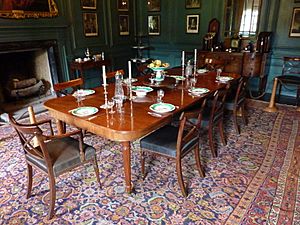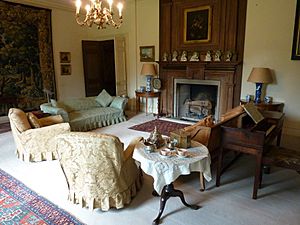Nunnington Hall facts for kids
Quick facts for kids Nunnington Hall |
|
|---|---|

South elevation
|
|
| General information | |
| Type | Manor house |
| Location | Nunnington, Ryedale, North Yorkshire, England |
| Coordinates | 54°12′20″N 0°58′26″W / 54.205432°N 0.973783°W (grid reference SE6779) |
| Owner | National Trust |
|
Listed Building – Grade I
|
|
| Designated | 14 July 1955 |
| Reference no. | 1168075 |
Nunnington Hall is a beautiful old country house in North Yorkshire, England. The River Rye flows right past the house. A stone bridge crosses the river, connecting the house grounds to the nearby village of Nunnington. This historic house is now looked after by the National Trust, which means you can visit it and explore its fascinating past!
The first mention of Nunnington Hall was way back in the 1200s. Many different families have owned it over the centuries. Some of these owners include William Parr, 1st Marquess of Northampton, Dr Robert Huicke, and Richard Graham, 1st Viscount Preston. The building you see today was mostly built in the 1680s when Richard Graham owned it.
Contents
History of Nunnington Hall
Long ago, in the medieval period, the land where Nunnington Hall stands belonged to a rich abbey in York called St Mary's Abbey. The name "Nunnington" actually comes from a nunnery that was likely on this very spot before the Norman Conquest around 1066. This nunnery closed down around 1200.
Early Owners and Changes
One of the earliest parts of the house still standing was built by William Parr, 1st Marquess of Northampton. He was the brother of Queen Catherine Parr, who was one of King Henry VIII's wives. William Parr lost the estate in 1553 because he supported Lady Jane Grey becoming queen.
Later, Dr Robert Huicke, who was a doctor to Queen Elizabeth I, became a tenant. He never lived at Nunnington, but his family managed the estate. Over the next 60 years, the Norcliffe family, who leased the property, made many changes to the house.
In 1681, Richard Graham, 1st Viscount Preston, became the owner. He was a very important person and made many of the changes you can still see today. However, he later lost his property for a time because he tried to help King James II return to France. Luckily, he was pardoned, and his lands were given back to him.
The Rutson and Fife Families
The house stayed in the Graham family until 1839, when it was sold to William Rutson. In 1920, William Rutson's great-niece, Margaret Rutson, inherited the hall. She was married to Ronald D'Arcy Fife. They did a lot of work to restore the house in the 1920s with the help of an architect named Walter Brierley.
When Margaret Fife passed away in 1952, she generously gave Nunnington Hall, most of its furniture, and its beautiful gardens to the National Trust. She also left a large sum of money to help take care of the property.
Gardens and Peacocks
Nunnington Hall is surrounded by 8 acres of gardens that are managed organically. The main walled garden is south of the house. It has lovely lawns, fruit orchards, rose beds, and special iris gardens. The orchards are also home to wildflowers like cowslips and primroses.
One of the most charming features of the gardens are the resident peacocks! They roam freely, adding to the beauty of the place. Sadly, in 2007, Bluey, the head of the peacock family, passed away.
Inside Nunnington Hall
When you visit Nunnington Hall, you enter through a simple entrance into the Stone Hall.
The Stone Hall
This room is in the oldest part of the house, dating back to the 1500s. Here, you can see a collection of animal skins and heads, like those from elephants, lions, and antelopes. There are also old weapons and armor on display. These belonged to Colonel Fife, who lived here in the 1900s. He also collected souvenirs from World War II, like a German tank crewman's helmet.
The Dining Room
The Dining Room you see today is set up to look like an Edwardian dining room, even though the Fife family used a different room for their meals. The walls are a dark turquoise color, which was chosen by Colonel Fife in the 1920s when this room was his smoking room.
Long before that, the first Lord Preston used this as his main bedroom. He added a new fireplace and wall panels.
Art and Objects
In this room, you can see paintings of the Graham family, who once owned the house. There are also many beautiful prints called mezzotints, which were given to the National Trust.
The dining table is set with an 18th-century dinner service from China, decorated with the Pitt family's coat of arms. You'll also spot fancy candlesticks, knives with "pistol grips," and a silver cake basket. On a side table, there's a lovely Meissen coffee set with flower decorations.
The room also has a late 18th-century sideboard with a special drawer that opens to reveal a lead-lined box for keeping wine cool. There are also old knife boxes and a pair of silver candle snuffers with the Rutson family crest.
Lord Preston's Room
This room was Lord Preston's private bedroom, but in his time, important guests would often be entertained here. It has a smaller room next to it for more privacy.
Ceiling Art
Look up at the ceiling in this room! You'll see paintings in panels that show the family crests of Viscount Preston and his wife, Lady Anne Howard. These paintings include their family mottos and are surrounded by golden angels.
Historical Pictures
There are also pictures of William Rutson, who bought Nunnington in 1839. You can also see an engraving of Richard Graham, the first Viscount Preston, and King James II. Richard Graham was even imprisoned in the Tower of London for trying to help King James II!
The Oak Hall
Viscount Preston also updated this room in the late 1600s. You can see his work in the wooden wall panels, the carvings on the staircase, and the fancy designs above the fireplaces and doorways.
The wooden panels in this room were once painted, but they were stripped bare in the 1920s during the renovations by the Fife family. The detailed carvings, especially the one above the fireplace with the Graham family's coat of arms, are thought to be by a skilled carpenter from York named John Etty.
The floor of this room has a unique pattern of squares and hexagons made from stone flags. This design was inspired by old architectural books from the 1600s.
Paintings in the Oak Hall
- A portrait of Charles, 3rd Viscount Preston, who died young, meaning his title and the house passed to his aunts.
- A painting of Edward Graham and his sister Catharine as children. Catharine lived to be 80 and married Lord Widdrington.
- Several paintings of horses and a groom by John Ferneley, including one of William Rutson, an owner of Nunnington Hall, on his horse.
Furniture in the Oak Hall
The Oak Hall has a very long oak table from the 1500s. Mrs. Fife found it in the kitchens and moved it here. On the table, there are two large bowls from the 1600s. There's also a cabinet from northern Europe with tea and coffee cups from the 1800s.
A tall clock from around 1760 belonged to William Rutson's grandfather, who was the mayor of Kendal. Near the stairs, you'll find a large cupboard made from old wooden panels and an Italian chest. In the stairwell, there's a beautiful tapestry from around 1700, showing oriental designs that were popular at the time.
The Drawing Room
Upstairs, above the Oak Hall, is the Drawing Room. This room holds a special treasure that was found right here at Nunnington!
A small painting called Shrimpers at Lyme Regis was discovered in a storage room by housekeepers. After five years of study by experts, it was believed to be by the famous artist Joseph Mallord William Turner! The painting has a faint inscription that says it was given by J.M. Turner in 1832. Today, this painting hangs in the Drawing Room.
The room also has a recently restored piano and a tall clock from around 1720. For those who love art, there's a painting called Grape Harvest in the South of France, which shows a glimpse of old rural life.
Colonel Fife's Dressing Room
This room was once part of the Drawing Room. Here, you can see items from Colonel Fife's time in the army, including his medals and awards. There are also presentation cups from when he played polo and raced horses in India.
You can also see photographs that show how much work was done to restore Nunnington Hall. One of the small watercolor paintings on display is a "View of Philae" by Edward Lear, who is famous for his silly poems and drawings.
Mrs Fife's Bedroom
The bed in this room is painted in a Neo-Classical style, which was popular in the early 1900s.
Among the family portraits, there's a lovely pastel portrait of Mrs. Fife as a young girl. There's also a pencil drawing of Colonel Fife from 1915. This room also displays some needlework by Fanny Wrather, Mrs. Fife's great-grandmother.
Mrs Fife's Dressing Room
This room is similar to a room downstairs and was also part of the changes made by the first Viscount Preston.
You can see portraits of women from the late 1700s. There's also a small wooden desk that might have been made by an apprentice as a masterpiece or used by a furniture salesman to show off his work.
The Oak Bedroom
The wooden panels in this room date back to when the Norcliffe family lived here (1583–1643). However, the corner fireplace was added later by Lord Preston in the late 1600s.
In front of the fireplace is a painted leather screen. This screen was made from a piece of old leather wall hangings that once decorated a room at Nunnington. The oak bed in this room is an example of an old bed frame that was updated over time with new posts and a canopy.
Above the door to the Bedroom Corridor, there's an early "borrow" light window. This window allowed natural light to reach the corridor, which was probably created during Lord Preston's changes. The Bedroom Corridor leads to the Reading Room, where visitors can relax.
The Panelled Bedroom
The wooden panels in this room are also from the time of the Norcliffe family. It's believed that the damage around the window was caused by Cromwellian soldiers who stayed at Nunnington during the Civil War.
This room and its small prayer room are said to be haunted by a presence that moves over the bed and through the wall.
On the walls, you'll see many samplers. These are examples of needlework made by young people long ago, showing their skill and good upbringing. The bed in this room is a special officer's traveling bed that could be taken apart and moved with an army.
The Nursery
In the 1920s, this room was used by the "odd boy," who ran errands for the household. Today, it's set up as a nursery, filled with children's furniture and toys, mostly from the Victorian period onwards.
You can also see "The Baby House," a large dollhouse from around 1800-1810. It's decorated in an 18th-century style and was made for the Rutson family. It was originally kept in the Drawing Room and wasn't meant to be a child's toy.
Images for kids







